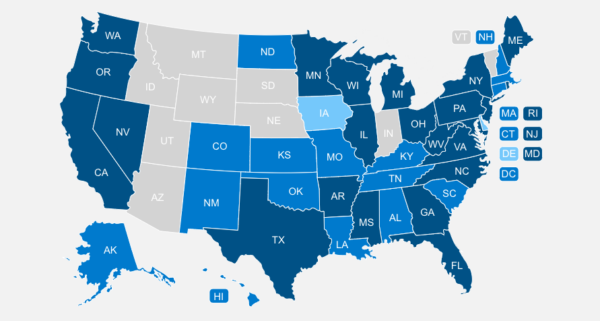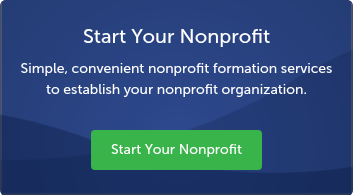How to Start a Nonprofit in Vermont: A Founder’s Step-by-Step Guide
 Whether you’re passionate about environmental conservation, community development, or social services, starting a nonprofit in Vermont can turn your vision into reality. However, navigating the formation process might seem overwhelming at first.
Whether you’re passionate about environmental conservation, community development, or social services, starting a nonprofit in Vermont can turn your vision into reality. However, navigating the formation process might seem overwhelming at first.
The good news? You don’t have to figure it out alone. With expert guidance from organizations like Labyrinth’s nonprofit formation services and this comprehensive guide, you’ll learn exactly how to start a nonprofit in Vermont – from planning your mission to securing your 501(c)(3) approval. Labyrinth’s Nonprofit Compliance Specialists bring over 15 years of nonprofit leadership experience to guide you through every step, backed by a 100% money-back guarantee on IRS tax exemption approval.
Ready to make a difference in your community? Let’s walk through the essential steps to establish your Vermont nonprofit organization and achieve tax-exempt status.
Planning Your Vermont Nonprofit
Before launching your nonprofit in Vermont, thorough planning sets the foundation for long-term success. With over 6,400 nonprofits already serving communities across the state, according to the Vermont Department of Financial Regulation record retention guidance, strategic preparation becomes essential for your organization’s sustainability.
Evaluating Your Mission and Goals
Your mission statement serves as the cornerstone of your nonprofit, defining its fundamental purpose and guiding every future decision. A powerful mission statement attracts donors, volunteers, and community involvement while helping verify if your organization stays on track. When crafting your mission statement, focus on making it concise, realistic, and inspirational. Additionally, ensure it clearly states your organization’s purpose and reflects core values.
- Gather input from potential board members, staff, and community stakeholders
- Define the specific needs your organization will address
- Outline measurable goals that align with your purpose
- Create clear evaluation criteria for programs and initiatives
Researching Similar Organizations
Vermont’s nonprofit sector generates more than $10 billion in revenue, according to the Vermont Department of Financial Regulation, with organizations spread across various sectors. Health and Human Services, Arts and Culture, and Community/Economic Development represent the largest nonprofit subsectors in Vermont, per the same state guidance.
- Identify potential collaboration opportunities through expert market analysis
- Understand service gaps in your chosen sector
- Evaluate partnership possibilities with established organizations
- Assess the competitive landscape with insights from specialists who’ve helped thousands of nonprofits launch successfully
Creating a Basic Budget Plan
Sound financial management starts with a comprehensive budget plan. The budget serves as a guide for future financial activities and helps assess your organization’s current financial health.
First, outline your projected income sources. Vermont nonprofits benefit from diverse funding streams, including grants, donations, and program revenues. Approximately 40% of Vermont’s nonprofit revenue centers in Chittenden County, according to the Vermont Department of Financial Regulation, so consider your geographic location when planning fundraising strategies.
Next, detail anticipated expenses. Vermont nonprofits paid nearly $3 billion in wages, and the average annual wage for nonprofit employees in Vermont stands at $62,510, according to the Vermont Department of Financial Regulation; factor these into your personnel budget planning.
- Startup costs and initial operating expenses
- Projected revenue from various sources
- Administrative and program-related costs
- Reserve funds for unexpected expenses
Remember that budgets require regular review and may need amendments during the year as your organization’s financial position changes. Consider working with Labyrinth’s nonprofit formation services to develop a sustainable financial strategy that aligns with your mission and goals. Their team can help you create realistic projections based on experience with Vermont nonprofits across all sectors.
Building Your Nonprofit Team
Assembling a strong leadership team marks a crucial milestone in establishing your Vermont nonprofit. A well-structured board and dedicated officers provide the governance foundation necessary for your organization’s success.
Finding Board Members
Vermont law requires a minimum of three directors for your nonprofit board. These individuals serve as stakeholders in your organization’s purpose and must be unrelated to meet IRS requirements. Although Vermont imposes no residency requirements, board members must be individuals rather than corporations or entities, per the Vermont Nonprofit Corporation Act.
Board members carry three primary legal responsibilities:
- Duty of Care: Ensuring prudent use of assets and overseeing activities that advance effectiveness
- Duty of Loyalty: Making decisions in the organization’s best interest, not personal gain
- Duty of Obedience: Ensuring compliance with laws and adherence to stated purposes
To find qualified board members, consider connecting through statewide board opportunity platforms. Furthermore, board members should possess skills aligned with essential functions:
- Financial oversight
- Fundraising capabilities
- Legal expertise
- Strategic planning
- Marketing and communications
Professional guidance from Labyrinth’s specialists can help identify and recruit board members who align with your mission while meeting legal requirements. Their team understands Vermont’s unique nonprofit landscape and can connect you with resources for building an effective board.
Required Officer Positions
Under Vermont law, your nonprofit must maintain specific officer positions to operate legally. The mandatory positions include President, Secretary, and Treasurer, per Vermont statute 11B § 8.40.
The president oversees board operations and facilitates meetings. The treasurer manages financial aspects and often serves as the chief financial officer. The secretary maintains meeting minutes and organizational records, as outlined in the Vermont Attorney General’s Charitable Nonprofit Board Guidance.
One individual may hold multiple officer positions simultaneously, except for the president and secretary roles, which must be filled by different people, ensuring proper checks and balances within your organization’s leadership structure (Vermont statute 11B § 8.40).
Officer responsibilities include preparing and maintaining meeting minutes, authenticating organizational records, and managing corporate documentation (Vermont statute 11B § 8.40).
Your initial organizational meeting serves as the foundation for establishing these positions. At this meeting, you will install the initial board of directors, determine officer titles, approve bylaws, adopt conflict of interest policies, and approve essential resolutions.
Labyrinth’s nonprofit formation services can guide you through structuring your board and officer positions effectively, ensuring compliance with Vermont regulations while fostering strong organizational leadership. Their secure nonprofit portal allows you to store all governance documents and track board decisions in one centralized location.
Legal Formation Steps
Establishing your nonprofit’s legal foundation requires careful attention to Vermont state regulations and federal requirements. Let’s explore the essential steps to formalize your organization.
Choosing Your Nonprofit Name
Selecting an appropriate name involves more than creative brainstorming. Vermont law mandates specific requirements for nonprofit names. Your organization’s name should include one of these terms: “corporation,” “incorporated,” “company,” “limited” or their abbreviations (corp., inc., co., ltd.). Moreover, your nonprofit’s name must be unique and distinguishable from other registered organizations in Vermont.
- Search the Vermont Secretary of State’s business database
- Verify domain name availability for online presence
- Check trademark databases to avoid potential conflicts
- Consider variations of your preferred name as backups
Filing Articles of Incorporation
The Articles of Incorporation officially establish your nonprofit in Vermont. This crucial document must be filed with the Vermont Secretary of State’s Corporations Division (802-828-2386, sos.vermont.gov). Professional assistance from Labyrinth ensures your filing meets both state and IRS requirements from the start, helping you avoid costly amendments later.
Your Articles of Incorporation must include:
- Organization name and principal office address
- Statement declaring public benefit or mutual benefit status
- Purpose clause aligned with IRS requirements for 501(c)(3) status
- Dissolution clause stating assets will be distributed to other 501(c)(3) organizations upon dissolution
- Registered agent information with Vermont street address
- Initial board of directors’ details
The filing fee for Vermont nonprofit Articles of Incorporation is $125. Since the Vermont template doesn’t meet IRS requirements for 501(c)(3) status, working with Labyrinth’s nonprofit formation services ensures your articles are drafted correctly from day one. Their specialists prepare customized articles that satisfy both Vermont state law and federal tax-exemption requirements, eliminating the need for future amendments.
Getting an EIN Number
Following incorporation approval, obtaining an Employer Identification Number (EIN) becomes essential. This nine-digit identifier, similar to a social security number for businesses, is mandatory even if your nonprofit won’t have employees, per IRS guidance on EINs.
The Internal Revenue Service (IRS) issues EINs through several methods:
- Online application (fastest option)
- Fax submission
- Mail-in Form SS-4
- Phone application (international applicants only)
Important considerations for EIN application:
- Wait until your organization is legally formed to apply (IRS EIN instructions for exempt organizations).
- Select “church or church-controlled organization or other nonprofit organization” as entity type (IRS guidance on EINs).
- Understand that EIN differs from state tax-exempt numbers (IRS guidance on EINs).
- Keep documentation readily accessible for future reference.
Once obtained, your EIN enables you to open organizational bank accounts, apply for 501(c)(3) status, submit required tax returns, handle employee-related tax matters, and establish state tax accounts (see the Vermont Department of Taxes: Start a Nonprofit).
Remember that applying for an EIN starts the three-year period during which your organization must file required returns to maintain tax-exempt status (IRS EIN instructions for exempt organizations). Labyrinth includes EIN acquisition as part of their comprehensive formation service, helping ensure proper timing and documentation for your nonprofit’s needs.
Applying for Tax Exemption
Securing tax-exempt status marks a pivotal step in establishing your Vermont nonprofit. After completing the incorporation process, obtaining federal and state tax exemptions enables your organization to operate effectively. Remember that formation alone does not grant tax-exempt status – you must apply separately to the IRS.
Preparing Form 1023
The Internal Revenue Service (IRS) requires Form 1023 or Form 1023-EZ for recognition as a 501(c)(3) tax-exempt organization.
- Standard Form 1023 filing fee: $600
- Form 1023-EZ filing fee: $275
Labyrinth’s nonprofit formation services can assist with determining which form suits your organization and handle the entire preparation process. With Labyrinth’s 100% IRS tax exemption approval guarantee, you can proceed confidently knowing your application will be prepared correctly. Their specialists manage all aspects of Form 1023 or 1023-EZ preparation, including responding to any IRS correspondence during the review process.
Upon approval, the IRS issues a Letter of Determination confirming your tax-exempt status. Filing within 27 months of formation ensures your exempt status dates back to your organization’s creation (IRS Instructions for Form 1023). Through their secure SOC 2 Type II certified portal, you can track your application’s progress in real-time and access all documentation whenever needed. Without this determination letter, donations to your organization are not tax-deductible for donors.
Vermont State Tax Requirements
Once you receive federal tax-exempt status, your organization may qualify for several state tax benefits in Vermont.
- Income Tax: No separate application is typically needed for Vermont corporate income tax exemption.
- Sales Tax: 501(c)(3) organizations may receive sales tax exemption (see the Vermont Department of Taxes sales and use tax guidance for nonprofits).
Specific requirements generally include:
- Register for a Vermont Business Tax Account through the Department of Taxes (802-828-2551, tax.vermont.gov) — see the Department of Taxes guidance.
- Complete Form S-3 (Vermont Sales Tax Exemption Certificate) — see the Department of Taxes guidance.
- Present Form S-3 to sellers at time of purchase — see the Department of Taxes guidance.
Important considerations for maintaining compliance:
- Pay taxes on unrelated business income (Vermont Department of Taxes: Start a Nonprofit).
- Collect and remit sales tax accordingly if conducting retail operations.
- File required returns within deadlines to maintain exempt status.
Professional assistance ensures proper navigation of both federal and state requirements. Labyrinth’s comprehensive approach includes guidance on Vermont-specific compliance requirements, helping you maintain your tax-exempt status year after year. Remember that losing federal tax-exempt status can revoke state exemptions (Vermont Department of Taxes: Nonprofits). For out-of-state nonprofits operating in Vermont, meeting the threshold of $100,000 in sales or 200 transactions within Vermont during any twelve-month period requires registration with the Department of Taxes (Vermont Department of Taxes sales and use tax guidance).
Setting Up Operations
Proper operational setup ensures your Vermont nonprofit’s long-term sustainability. After securing legal status and tax exemptions, establishing robust business practices becomes essential for success.
Opening a Bank Account
A dedicated nonprofit checking account separates organizational finances from personal funds.
- Online and mobile banking capabilities
- Bill payment services
- Multiple user access levels
- Debit cards for authorized personnel
- Overdraft protection options
Labyrinth’s nonprofit formation services can assist in selecting appropriate banking solutions aligned with your organization’s needs, ensuring you have the proper documentation ready for account opening.
Creating Essential Policies
Establishing comprehensive policies safeguards your nonprofit’s operations. Begin by developing these fundamental guidelines:
- Financial Controls: Annual review procedures, documentation requirements, approval processes, and asset protection measures (see the Vermont Attorney General’s guidance).
- Record Management Policy outlining retention periods, storage methods, disposal procedures, and security protocols (see the Vermont Department of Financial Regulation record retention guidance).
- Employee-Related Policies: Non-discrimination guidelines, payroll tax procedures, workers’ compensation coverage, and unemployment insurance requirements (see the Vermont Attorney General’s guidance).
Setting Up Record Keeping
Effective record management forms the backbone of nonprofit compliance. Vermont law mandates specific retention requirements based on record type. For example, the Vermont Department of Financial Regulation record retention guidance outlines common timelines.
Financial Records:
- Transaction documentation: 7 years from date
- Loan-related documents: 7 years post-payoff
- Audit reports: Permanent retention
Organizational Documents:
- Formation meeting minutes
- Board resolutions
- EIN documentation
- Tax-exemption letters
Consider implementing these record-keeping practices:
- Adopt written management policies
- Establish secure storage systems
- Create backup procedures
- Implement disposal protocols
- Maintain access controls
Your record management system should enable transaction reconstruction, financial position monitoring, compliance verification, decision documentation, and asset protection (see the Vermont Attorney General’s guidance).
Through meticulous record-keeping, your nonprofit demonstrates accountability to stakeholders and regulatory bodies alike. Labyrinth’s secure client portal provides a centralized location for storing all critical documents, ensuring you maintain compliance with Vermont’s retention requirements while having instant access to important records.
Ongoing Compliance Requirements
Maintaining your Vermont nonprofit’s good standing requires attention to several recurring obligations. Understanding these requirements helps prevent lapses that could jeopardize your tax-exempt status.
Annual Filings with Vermont
Vermont nonprofits must file biennial reports with the Secretary of State every two years. The filing fee is $35, and reports are due based on your incorporation month. Missing this deadline can result in administrative dissolution, though reinstatement may be possible with additional fees.
Federal Form 990 Requirements
The IRS requires annual information returns from all tax-exempt organizations:
- Form 990-N (e-Postcard): For organizations with gross receipts under $50,000
- Form 990-EZ: For organizations with gross receipts under $200,000 and assets under $500,000
- Form 990: For larger organizations exceeding these thresholds
Filing deadlines fall on the 15th day of the 5th month after your fiscal year ends. Failure to file for three consecutive years results in automatic revocation of tax-exempt status (IRS EIN instructions for exempt organizations).
Charitable Solicitation Registration
If your nonprofit plans to fundraise in Vermont, you must register with the Secretary of State before soliciting donations. This separate registration from incorporation ensures donor protection and transparency. Annual renewal requirements apply, with fees based on contribution levels.
Professional assistance from Labyrinth’s nonprofit formation services ensures you never miss critical deadlines. Their compliance specialists track all filing requirements and provide timely reminders, protecting your nonprofit’s status while you focus on your mission.
Conclusion
Starting a nonprofit in Vermont requires careful planning, dedicated teamwork, and thorough attention to legal requirements. Most importantly, proper documentation and compliance remain essential throughout your organization’s lifecycle.
Your success depends on several key factors: a clear mission statement, qualified board members, proper legal formation, and sound operational practices. Additionally, maintaining accurate records helps demonstrate accountability while protecting your tax-exempt status.
Above all, remember that launching a nonprofit means more than paperwork – it represents your commitment to making positive changes in Vermont communities. Labyrinth’s nonprofit formation services stand ready to guide you through each step of establishing your nonprofit organization. Their expert Nonprofit Compliance Specialists, each with 15+ years of nonprofit leadership experience, provide 1-on-1 support throughout your formation journey. Combined with their 100% money-back guarantee on 501(c)(3) approval and transparent pricing with no hidden fees, you can focus on your mission while they handle the complexities.
Therefore, take time to carefully plan each aspect of your nonprofit formation. Start with thorough research, build a strong team, and establish robust operational systems. Professional guidance can help transform your vision into reality while avoiding common pitfalls along the way. From initial incorporation through IRS approval and beyond, Labyrinth’s end-to-end formation support ensures nothing falls through the cracks. Their services include everything from EIN acquisition to first-year fundraising registration for bundled packages.
Remember, your dedication to serving others through a nonprofit organization adds to Vermont’s rich tradition of community service and social impact. Start your nonprofit journey today and join the thousands of organizations making a difference across the Green Mountain State. With the right support and resources, your nonprofit can thrive and create lasting positive change in Vermont communities.


![Your 501(c)(3) Approval Guaranteed{{ include_custom_fonts({"Museo Sans":["Bold","Bold Italic","Regular","Regular Italic"]}) }}](https://no-cache.hubspot.com/cta/default/560178/interactive-194101957210.png)
![Start Your Nonprofit with Confidence{{ include_custom_fonts({"Museo Sans":["Bold","Bold Italic","Regular","Regular Italic"]}) }}](https://no-cache.hubspot.com/cta/default/560178/interactive-194101957151.png)
